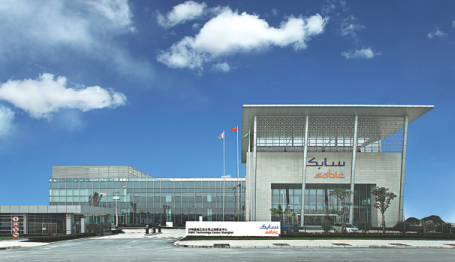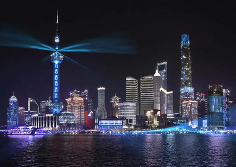SABIC poised to capitalize on innovative advantages

SABIC Technology Center in Shanghai is delivering the latest sustainable solutions to its clients. [Photo/China Daily]
Over the past decade, Saudi Basic Industries has witnessed Kangqiao district of Shanghai's Pudong New Area transform from being just fields into a booming industrial cluster.
During the course of this dramatic change, SABIC has played an indispensable role.
SABIC, a global leader in diversified chemicals, is a public company established in Riyadh, Saudi Arabia, in 1976. It engages in three strategic business units: petrochemicals, agri-nutrients and specialties.
SABIC was among the first multinationals to participate in China's reform and opening-up.
"Over past decades, we have witnessed the country's rapid economic takeoff and the growth of the petrochemical industry, and we are also a part of it," said Li Lei, vice-president and regional head of North Asia at SABIC.
Since its first step in Shanghai in the 1980s, SABIC has constantly expanded its footprint in the country.
In 2013, SABIC established its research and development center in Kangqiao of Shanghai with a combined investment of $100 million to meet the needs of fast expansion.
With an area of 60,000 square meters, the center is part of SABIC's global innovation network. It serves Chinese and Northeast Asian markets as a major strategic R&D hub and focuses on research projects, ranging from basic to applied science.
With the rising importance of the Chinese market, the center now works as the regional headquarters of SABIC.
According to the company, China has become one of the most important strategic markets for SABIC globally, accounting for approximately 20 percent of its global revenue.
Li said they will consider further upgrading the function of the center as SABIC continues to expand its business and investment in China.
"The Chinese market is the key driving force for SABIC's growth and investment strategy," Li said.
Li noted that the company has pledged to expand its presence in China through sustainable and innovative paths, which aligns with the country's 14th Five-Year Plan (2021-25) and economic objectives through to the year 2035.
"Innovation and sustainable development are the main intents of the country's 14th Five-Year Plan and they give more emphasis on high-quality development. As one of the world's largest petrochemical manufacturers, we are very glad to see more important development opportunities in the future," Li said.
"We will make every effort to capitalize on emerging opportunities and deliver our commitment to customers and partners in China," he added.
In addition to its three plants-in East China's Shanghai, South China's Guangzhou and Southwest China's Chongqing, SABIC established the joint venture of Sinopec SABIC Tianjin Petrochemical. SSTPC has a mega-sized petrochemical enterprise consisting of nine world-scale production plants.
In addition, a world-class polycarbonate plant in Tianjin is expected to be operational this year.
SABIC has also signed an investment memorandum of understanding for a mega petrochemical project with the Fujian government. The deal, signed in September 2018, marked a major milestone in its development.
China announced that it will strive to peak its carbon emissions by 2030 and achieve carbon neutrality by 2060. The great ambitions for green development have aroused concern from industries with high energy consumption.
As a leading player in the petrochemical industry, SABIC said it will continue to introduce more innovative technologies to support China's environmental goals.
The company said it has been looking for more applications of new technologies, such as alternative solutions for energy consumption.
Earlier this year, SABIC signed an agreement with chemical companies BASF and Linde Group to develop innovative solutions focusing on one of the petrochemical industries' core processes. By using renewable electricity instead of the fossil fuel gas typically used for heating processes, the new technology has the potential to reduce carbon dioxide emissions by as much as 90 percent, according to the company.
SABIC will also continue to boost innovation through its global technology network, known as SABIC Corporate Technology and Innovation. With more than 1,500 employees working on various research projects at 20 centers around the world, the network delivers differentiated, sustainable and well-priced innovation solutions. It has also brought in more than 10,000 patents.
"Technology and innovation are the essence of the chemical industry. They are the major driving forces highly valued by SABIC," Li said. "China's innovation-driven strategy also inspires SABIC to better unleash its technology and innovation."
"As China continues to play a pivotal role in SABIC's global marketing strategy, we want to join hands with all partners during the journey of innovation-driven quality development," Li said.
Despite the COVID-19 pandemic, SABIC has seen growth globally. SABIC reported a strong performance in the second quarter of this year, with global revenue reaching $11.31 billion, an increase of 13 percent compared to the previous quarter and a 72 percent increase year-on-year.
Net income during the second quarter amounted to $2.04 billion, an increase of 57 percent compared to the first quarter.
 Contact Us
Contact Us

 Brilliant light show to illuminate Huangpu River
Brilliant light show to illuminate Huangpu River Maple leaves paint splendid scenery in Pudong
Maple leaves paint splendid scenery in Pudong Appreciate alluring lotus blossoms in Pudong's Century Park
Appreciate alluring lotus blossoms in Pudong's Century Park New pedestrian street boosts Pudong's night economy
New pedestrian street boosts Pudong's night economy 


